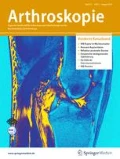Zusammenfassung
Die klinische Untersuchung spielt noch immer eine wichtige Rolle bei der Diagnostik von akuten Verletzungen und chronischen Beschwerden des Sprunggelenks. Durch eine ausführliche Anamneseerhebung sowie einen strukturierten Untersuchungsablauf, der bei Bedarf durch spezifische Tests ergänzt wird, kann eine reproduzierbare Untersuchungsqualität gewährleistet werden. Ein bewährter klinischer Untersuchungsablauf des Sprunggelenks wird vorgestellt und von der Anamnese über die Inspektion und Palpation, die Prüfung von Beweglichkeit und Kraft, die Stabilitätsprüfung bis zu spezifischen Funktionstests beleuchtet.
Abstract
Physical examination still plays a key role in the diagnosis of acute injuries and chronic disorders of the ankle joint. A reproducible diagnostic quality can be obtained by taking the patient’s history in detail and following a structured examination pathway, which can be expanded with further specific tests if required. This overview article presents a proven physical examination pathway of the ankle joint and explains it step by step from taking the case history to inspection and palpation, testing of motion and strength, and testing of joint stability up to specific function tests.






Literatur
Waldecker U, Hofmann G, Drewitz S (2011) Epidemiologic investigation of 1394 feet: coincidence of hindfoot malalignment and Achilles tendon disorders. Foot Ankle Surg 18(2):119–123
Fredericson M, Bergman AG, Hoffman KL, Dillingham MS (1995) Tibial stress reaction in runners. Correlation of clinical symptoms and scintigraphy with a new magnetic resonance imaging grading system. Am J Sports Med 23(4):472–481
Ryf C, Weymann A (1995) The neutral zero method – A principle of measuring joint function. Injury. Elsevier 26(Suppl.1):1–11
Van Dijk CN et al (1996) Physical examination is sufficient for the diagnosis of sprained ankles. J Bone Joint Surg [Br] 78-B:958–962
Lynch SA (2002) Assessment of the Injured Ankle in the Athlete. J Athlet Train 37(4):406–412
Sman AD, Hiller CE, Refshauge KM (2013) Diagnostic accuracy of clinical tests for diagnosis of ankle syndesmosis injury: a systematic review. Br J Sports Med 47(10):620–628
Cotton FJ (1910) Fractures and joint dislocations. WB Saunders, Philadelphia, PA, S. 549
Teitz CC, Harrington RM (1998) A biochemical analysis of the squeeze test for sprains of the syndesmotic ligaments of the ankle. Foot Ankle Int 19(7):489–492
Ogilvie-Harris DJ, Reed SC (1994) Disruption of the ankle syndesmosis: diagnosis and treatment by arthroscopic surgery. Arthroscopy 10(5):561–568
Medical Research Council (1976) Aids to the examination of the peripheral nervous system. Memorandum No. 45. HMSO 1976:1. London, England
Lee S, Kim H, Choi S, Park Y, Kim Y, Cho B (2003) Clinical usefulness of the two-site semmes-weinstein monofilament test for detecting diabetic peripheral neuropathy. J Korean Med Sci 18(1):103–107
Simmonds FA (1957) The diagnosis of the ruptured achilles tendon. Practitioner 179:56–58
Thompson TC (1962) A test for rupture of the tendo achillis. Acta Orthop Scand 32:461–465
Douglas J, Kelly M, Blachut P (2009) Clarification of the Simmonds-Thompson test for rupture of an achilles tendon. May 20, 1:2
Matles AL (1975) Rupture of the tendo achilles: another diagnostic sign. Bull Hosp Joint Dis 36:48–51
Author information
Authors and Affiliations
Corresponding author
Ethics declarations
Interessenkonflikt
P. Reuter, T. Klestil und T. Buchhorn geben an, dass kein Interessenkonflikt besteht.
Dieser Beitrag beinhaltet keine Studien an Menschen oder Tieren.
Rights and permissions
About this article
Cite this article
Reuter, P., Klestil, T. & Buchhorn, T. Klinische Untersuchung des Sprunggelenks. Arthroskopie 28, 78–85 (2015). https://doi.org/10.1007/s00142-015-0007-4
Published:
Issue Date:
DOI: https://doi.org/10.1007/s00142-015-0007-4

